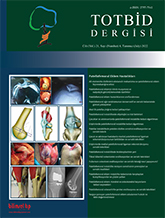
Patellofemoral joint is the second most frequent site for cartilage lesions in the knee after medial femoral condyle. The etiology includes patellar instability, direct trauma, repetitive microtrauma, patellar maltracking and idiopathic conditions. Anterior knee pain during activity or after prolonged sitting (theater sign) is a frequent symptom. Ascending or descending stairs may also be difficult among the patients. History of patellar instability and symptoms related to instability may be present in some of the patients. Patients with patellofemoral cartilage defects and who do not gain from conversative treatment methods are candidates for cartilage restorative surgery. Some of the anatomic and biomechanical features of patellofemoral joint render its restorative surgery difficult related to other locations which may lead to worse results. While most of the tibiofemoral lesions can be treated arthroscopically, an arthrotomy is usually needed for patellofemoral lesions. Current studies suggest that microfracture treatment is good for lesions < 2 cm2 . For lesions 2-4 cm2 ACI (autologous chondrocyte implantation) OAT (osteochondral autologous transfer), OCA (osteochondal allograft) may be used. Autologous chondrocyte implantation or OCA is recommended for lesions > 4 cm2. Patellofemoral arthroplasty is a salvage procedure option for patients with failed restorative procedures and/or severe patellofemoral arthrosis who are younger than 60 years old.